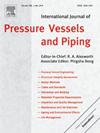复合材料包覆压力容器中薄壁金属内衬临界屈曲压力的理论和实验研究
IF 3
2区 工程技术
Q2 ENGINEERING, MECHANICAL
International Journal of Pressure Vessels and Piping
Pub Date : 2024-10-05
DOI:10.1016/j.ijpvp.2024.105335
引用次数: 0
摘要
复合材料包覆压力容器(COPV)因其重量轻、强度高而被广泛应用于高压气体储运领域。在工程设计中,通常使用自动涂漆来提高带金属内衬的复合材料包覆压力容器的疲劳寿命。然而,过高的自动修整压力可能会导致金属内衬屈曲损坏。为了确定自润滑的上限(临界屈曲压力)并分析其对 COPV 安全系数的影响,基于经典层压板理论和约束屈曲理论,建立了关于金属内衬临界屈曲压力的理论计算模型。然后,通过纤维缠绕工艺制备了带有薄壁焊接金属内衬的 COPV。为了监测和判断内衬的屈曲破坏模式,通过逐步加载和卸载测量了 COPV 筒体的圆周应变。最后,讨论了金属内衬的材料和尺寸对压力比(COPV 金属内衬第一层破坏压力与临界屈曲压力之比)的影响。当金属衬垫的直径与厚度比 (R/t) 大于 35 时,6063-T5 铝合金衬垫和 S30408 不锈钢衬垫的压力比均超过 2.25。然而,R/t ≤ 60 的 6061-T6 铝合金衬垫的压力比低于 1.85,这表明屈服强度更高、弹性模量更低的金属衬垫对纤维缠绕层的利用率更高。由于现行设计标准仅通过安全系数和各种型式试验及其评价方法来确保 COPV 的可靠性,因此提出的理论计算方法可减少 COPV 在设计和试验过程中的不确定性。本文章由计算机程序翻译,如有差异,请以英文原文为准。
Theoretical and experimental research on the critical buckling pressure of the thin-walled metal liner installed in the composite overwrapped pressure vessel
Composite overwrapped pressure vessels (COPVs) are widely used in the field of high-pressure gas storage and transportation because of their light weight and high strength. In engineering, autofrettage is usually used to improve the fatigue life of composite pressure overwrapped vessels with metal liners. However, excessive pressure of autofrettage could cause buckling damage to the metal liner. In order to determine the upper limit of autofrettage (critical buckling pressure) and analyze its influence on the safety factor of COPVs, a theoretical calculation model of the critical buckling pressure about the metal liner was established based on classical laminated plate theory and the confined buckling theory. Then, a COPV with thin-walled welded metal liner was prepared by fiber winding process. In order to monitor and judge the buckling damage mode of the liner, the circumferential strain of the COPV's cylinder was measured by loading and unloading step-by-step. Finally, the influence of materials and dimensions of the metal liner on the pressure ratio (the ratio of the first layer failure pressure to the critical buckling pressure of the COPV's metal liner) was discussed. When the diameter to thickness ratio (R/t) of the metal liner was greater than 35, the pressure ratios of the 6063-T5 aluminum alloy liner and the S30408 stainless steel liner both exceeded 2.25. However, the pressure ratio of 6061-T6 aluminum alloy liner with R/t ≤ 60 was lower than 1.85, which shows that the metal liner with higher yield strength and lower elastic modulus has higher utilization rate of fiber winding layers. Due to the fact that the current design standards only ensure the reliability of COPVs through safety factors and various type testing with their evaluation methods, the proposed theoretical calculation method can reduce the uncertainty of COPVs during the design and testing rounds.
求助全文
通过发布文献求助,成功后即可免费获取论文全文。
去求助
来源期刊
CiteScore
5.30
自引率
13.30%
发文量
208
审稿时长
17 months
期刊介绍:
Pressure vessel engineering technology is of importance in many branches of industry. This journal publishes the latest research results and related information on all its associated aspects, with particular emphasis on the structural integrity assessment, maintenance and life extension of pressurised process engineering plants.
The anticipated coverage of the International Journal of Pressure Vessels and Piping ranges from simple mass-produced pressure vessels to large custom-built vessels and tanks. Pressure vessels technology is a developing field, and contributions on the following topics will therefore be welcome:
• Pressure vessel engineering
• Structural integrity assessment
• Design methods
• Codes and standards
• Fabrication and welding
• Materials properties requirements
• Inspection and quality management
• Maintenance and life extension
• Ageing and environmental effects
• Life management
Of particular importance are papers covering aspects of significant practical application which could lead to major improvements in economy, reliability and useful life. While most accepted papers represent the results of original applied research, critical reviews of topical interest by world-leading experts will also appear from time to time.
International Journal of Pressure Vessels and Piping is indispensable reading for engineering professionals involved in the energy, petrochemicals, process plant, transport, aerospace and related industries; for manufacturers of pressure vessels and ancillary equipment; and for academics pursuing research in these areas.

 求助内容:
求助内容: 应助结果提醒方式:
应助结果提醒方式:


